Wind Speed Prediction with Spatio–Temporal Correlation: A Deep Learning Approach
Abstract
:1. Introduction
- (1)
- Physical methods, such as numerical weather prediction (NWP)—an accurate technique over longer horizons (from several hours to several days) [10]—formulate the problem of wind speed prediction as a set of high-dimensional, non-linear, differential algebraic equations, according to meteorology and computational fluid dynamics theories. Though physical methods have a good theory base, there are still many factors that limit their application [11], including the demand for considerable computational resources, relatively coarse spatial and temporal resolutions, high dependency for full and accurate information of the environment, etc.
- (2)
- Statistical methods find statistical regularities or patterns in massive historical data by establishing the mapping relationship between the predicted wind speed and explanatory variables [12]. These methods include the time-series analysis method [13], the Kriging interpolation method [14], the augmented Kriging interpolation method [15], clustering analysis [16], Von Mises distribution [17], etc.
- (3)
- Artificial intelligence (AI) methods, inspired by bionics and natural laws, intend to represent the complex nonlinear relationship between the inputs and the outputs. Various methods have been adopted for wind speed prediction, such as artificial neural networks (ANN) [18], support vector regressor (SVR), recurrent neural networks (RNN) [19], etc. However, the majority of the AI methods reported in the literature have shallow architectures and lack a targeted processing mechanism for spatial information. Capturing the temporal dependency and spatial correlation more specifically and pointedly according to their characteristics is a challenging task.
2. Spatial Correlation of Wind Speed
2.1. Description with Visualization
2.2. Mathematical Description
3. Spatio–Temporal Sequence Modeling
4. Convolutional Neural Networks
4.1. Convolutional Layer
4.2. Pooling Layer
4.3. Fully-Connected Layer
5. The Proposed Model
5.1. The Architecture of the Proposed Model
5.2. Input Variable Selection
5.3. Training Algorithm for PDCNN
5.4. Evaluation Indices
6. Case Study
6.1. Database
6.2. Model Configuration and Implement Details
6.3. Baseline Algorithms
6.4. Performance Analysis
6.5. Computational Complexity
6.6. Discussion
7. Conclusions
Acknowledgments
Author Contributions
Conflicts of Interest
References
- Ronay, A.; Olga, F.; Enrico, Z. Two machine approaches for short-term wind speed time-series prediction. Energy Procedia 2011, 12, 770–778. [Google Scholar] [CrossRef]
- Wang, Y.; Zhang, N.; Kang, Q.; Xia, Q. An efficient approach to power system uncertainty analysis with high-dimensional dependencies. IEEE Trans. Power Syst. 2018. [Google Scholar] [CrossRef]
- Wang, X.; Guo, P.; Huang, X. A review of wind power forecasting models. IEEE Trans. Neural Netw. 2016, 27, 1734–1746. [Google Scholar] [CrossRef]
- Zhu, Q.; Chen, J.; Duan, X.; Sun, X.; Li, Y.; Shi, D. A Method for Coherency Identification Based on Singular Value Decomposition. In Proceedings of the IEEE Power and Energy Society General Meeting (PESGM), Boston, MA, USA, 17–21 July 2016; pp. 1–5. [Google Scholar] [CrossRef]
- Ren, Y.; Suganthan, P.N.; Srikanth, N. A Comparative Study of Empirical Mode Decomposition-Based Short-Term Wind Speed Forecasting Methods. IEEE Trans. Sustain. Energy 2015, 6, 236–244. [Google Scholar] [CrossRef]
- Lowery, C.; O’Malley, M. Impact of wind forecast error statistics upon unit commitment. IEEE Trans. Sustain. Energy 2012, 3, 760–768. [Google Scholar] [CrossRef]
- Ju, W.; Sun, K.; Qi, J. Multi-layer interaction graph for analysis and mitigation of cascading outrages. IEEE J. Emerg. Sel. Top. Circuits Syst. 2017, 7, 239–249. [Google Scholar] [CrossRef]
- Ju, P.; Li, H.; Gan, C.; Liu, Y.; Yu, Y.; Liu, Y. Analytical Assessment for Transient Stability Under Stochastic Continuous Disturbances. IEEE Trans. Power Syst. 2018, 33, 2004–2014. [Google Scholar] [CrossRef]
- Damousis, I.G.; Alexiadis, M.C.; Theocharis, J.B.; Dokopoulos, P.S. A fuzzy model for wind speed prediction and power generation in wind parks using spatial correlation. IEEE Trans. Energy Convers. 2004, 19, 352–361. [Google Scholar] [CrossRef]
- Chen, N.; Qian, Z.; Nabney, I.T.; Meng, X. Wind Power Forecasts Using Gaussian Processes and Numerical Weather Prediction. IEEE Trans. Power Syst. 2014, 29, 656–665. [Google Scholar] [CrossRef]
- Soman, S.S.; Zareipour, H.; Malik, O.; Mandal, P. A review of wind power and wind speed forecasting methods with different time horizons. In Proceedings of the North American Power Symposium, Arlington, TX, USA, 26–28 September 2010; pp. 1–8. [Google Scholar] [CrossRef]
- Ding, Y.; Zhou, H.; Tan, Z.; Chen, Y.; Ding, J. The influence of wind direction on short-term wind power prediction: A case study in north China. In Proceedings of the IEEE PES Innovative Smart Grid Technologies, Tianjin, China, 21–24 May 2012; pp. 1–5. [Google Scholar] [CrossRef]
- Ulrich, F.; Matthias, L.; Kai, M.; Mönnich, K.; Waldl, H.; Beyer, H.G.; Luig, A. Short-term prediction of the aggregated power output of wind farms—A statistical analysis of the reduction of the prediction error by spatial smoothing effects. J. Wind Eng. Ind. Aerodyn. 2002, 90, 231–246. [Google Scholar]
- Cellura, M.; Cirrincione, G.; Marvuglia, A. Wind speed spatial estimation for energy planning in Sicily: Introduction and statistical analysis. Renew. Energy 2008, 33, 1237–1250. [Google Scholar] [CrossRef]
- Hur, J.; Baldick, R. Spatial prediction of wind farm outputs using the Augmented Kriging-based Model. In Proceedings of the IEEE Power and Energy Society General Meeting, San Diego, CA, USA, 22–26 July 2012. [Google Scholar] [CrossRef]
- Kusiak, A.; Li, W. Short-term prediction of wind power with a clustering approach. Renew. Energy 2010, 35, 2362–2369. [Google Scholar] [CrossRef]
- Carta, J.A.; Bueno, C.; Ramírez, P. Statistical modeling of directional wind speeds using mixtures of von Mises distributions: Case study. Energy Convers. Manag. 2008, 49, 897–907. [Google Scholar] [CrossRef]
- Bechrakis, D.A.; Sparis, P.D. Correlation of wind speed between neighboring measuring stations. IEEE Trans. Energy Convers. 2004, 19, 400–406. [Google Scholar] [CrossRef]
- Barbounis, T.G.; Theocharis, J.B. Locally recurrent neural networks optimal filtering algorithms: Application to wind speed prediction using spatial correlation. In Proceedings of the 2005 IEEE International Joint Conference on Neural Networks, Montreal, QC, Canada, 31 July–4 August 2005; pp. 2711–2716. [Google Scholar] [CrossRef]
- Bengio, Y. Learning deep architectures for AI. Found Trends Mach. Learn. 2009, 2, 1–127. [Google Scholar] [CrossRef]
- Lemley, J.; Bazrafkan, S.; Corcoran, P. Deep learning for consumer devices and services: Pushing the limits for machine learning, artificial intelligence, and computer vision. IEEE Consum. Electron. Mag. 2017, 6, 48–56. [Google Scholar] [CrossRef]
- Dalto, M.; Matuško, J.; Vašak, M. Deep neural networks for ultra-short-term wind forecasting. In Proceedings of the 2015 IEEE International Conference on Industrial Technology (ICIT), Seville, Spain, 17–19 March 2015; pp. 1657–1663. [Google Scholar] [CrossRef]
- Zhang, C.Y.; Chen, C.L.P.; Gan, M.; Chen, L. Predictive Deep Boltzmann Machine for Multiperiod Wind Speed Forecasting. IEEE Trans. Sustain. Energy 2015, 6, 1416–1425. [Google Scholar] [CrossRef]
- Wang, H.; Wang, G.; Li, G.; Peng, J.; Liu, Y. Deep belief network based deterministic and probabilistic wind speed forecasting approach. Appl. Energy 2016, 182, 80–93. [Google Scholar] [CrossRef]
- Khodayar, M.; Kaynak, O.; Khodayar, M.E. Rough Deep Neural Architecture for Short-term Wind Speed Forecasting. IEEE Trans. Ind. Inform. 2017, 13, 2770–2779. [Google Scholar] [CrossRef]
- Hu, Y.; You, J.; Liu, J.N.K.; Chan, P.W. Continuous RBM Based Deep Neural Network for Wind Speed Forecasting in Hong Kong. In Proceedings of the International Conference on Image Processing, Computer Vision, and Pattern Recognition (IPCV), Las Vegas, NV, USA, 27–30 July 2015; pp. 368–374. [Google Scholar]
- Hu, Q.; Zhang, R.; Zhou, Y. Transfer learning for short-term wind speed prediction with deep neural networks. Renew. Energy 2016, 85, 83–95. [Google Scholar] [CrossRef]
- Qureshi, A.; Khan, A.; Zameer, A.; Usman, A. Wind Power Prediction using Deep Neural Network based Meta Regression and Transfer Learning. Appl. Soft Comput. 2017, 58, 742–755. [Google Scholar] [CrossRef]
- Shi, B.; Bai, X.; Yao, C. An End-to-End Trainable Neural Network for Image-Based Sequence Recognition and Its Application to Scene Text Recognition. IEEE Trans. Pattern Anal. Mach. Intell. 2017, 39, 2298–2304. [Google Scholar] [CrossRef] [PubMed]
- Feng, J.; Li, F.; Lu, S.; Liu, J.; Ma, D. Injurious or noninjurious defect identification from MFL images in pipeline inspection using convolutional neural network. IEEE Trans. Instrum. Meas. 2017, 66, 1883–1892. [Google Scholar] [CrossRef]
- Bouvrie, J. Notes on Convolutional Neural Networks. MIT CBCL Technical Report. 2006. Available online: http://copyrights.org/5869/1/cnn_tutorial.pdf (accessed on 10 Dec 2007).
- Trappenberg, T.; Ouyang, J.; Back, A. Input variable selection: Mutual information and linear mixing measures. IEEE Trans. Knowl. Data Eng. 2006, 18, 37–46. [Google Scholar] [CrossRef]
- Hu, Q.; Su, P.; Yu, D.; Liu, J. Pattern-Based Wind Speed Prediction Based on Generalized Principal Component Analysis. IEEE Trans. Sustain. Energy 2014, 5, 866–874. [Google Scholar] [CrossRef]
- Draxl, C.; Clifton, A.; Hodge, B.; McCaa, J. The wind integration national dataset (WIND) toolkit. Appl. Energy 2015, 151, 355–366. [Google Scholar] [CrossRef]
- Salamon, J.; Bello, J.P. Deep Convolutional Neural Networks and Data Augmentation for Environmental Sound Classification. IEEE Signal Process. Lett. 2017, 24, 279–283. [Google Scholar] [CrossRef]
- Glorot, X.; Bordes, A.; Bengio, Y. Deep sparse rectifier neural networks. Proc. Int. Conf. Artif. Intell. Stat. 2011, 15, 315–323. [Google Scholar]
- Hinton, G.E.; Srivastava, N.; Krizhevsky, A. Improving neural networks by preventing co-adaptation of feature detectors. arXiv, 2012; arXiv:1207.0580. [Google Scholar]
- James, B.; Breuleux, O.; Bastien, F.; Lamblin, P.; Pascanu, R.; Desjardins, G.; Turian, J.; Warde-Farley, D.; Bengio, Y. Theano: A CPU and GPU math compiler in Python. In Proceedings of the 9th Python in Science Conference, Austin, TX, USA, 28 June–30 July 2010; pp. 3–10. [Google Scholar]
- Tanaka, I.; Ohmori, H. Method selection in different regions for short-term wind speed prediction in Japan. In Proceedings of the 2015 54th Annual Conference of the Society of Instrument and Control Engineers of Japan (SICE), Hangzhou, China, 28–30 July 2015; pp. 189–194. [Google Scholar] [CrossRef]
- Shi, X.; Chen, Z.; Wang, H.; Yeung, D.; Wong, W.; Woo, W. Convolutional LSTM network: A machine learning approach for precipitation nowcasting. arXiv, 2015; arXiv:1506.04214v2. [Google Scholar]
- Gschwind, M.; Kaldewey, T.; Tam, D.K. Optimizing the efficiency of deep learning through accelerator virtualization. IBM J. Res. Dev. 2017, 61, 12:1–12:11. [Google Scholar] [CrossRef]
- Melani, A.; Bertogna, M.; Bonifaci, V.; Marchetti-Spaccamela, A.; Buttazzo, G. Schedulability Analysis of Conditional Parallel Task Graphs in Multicore Systems. IEEE Trans. Comput. 2017, 66, 339–353. [Google Scholar] [CrossRef]

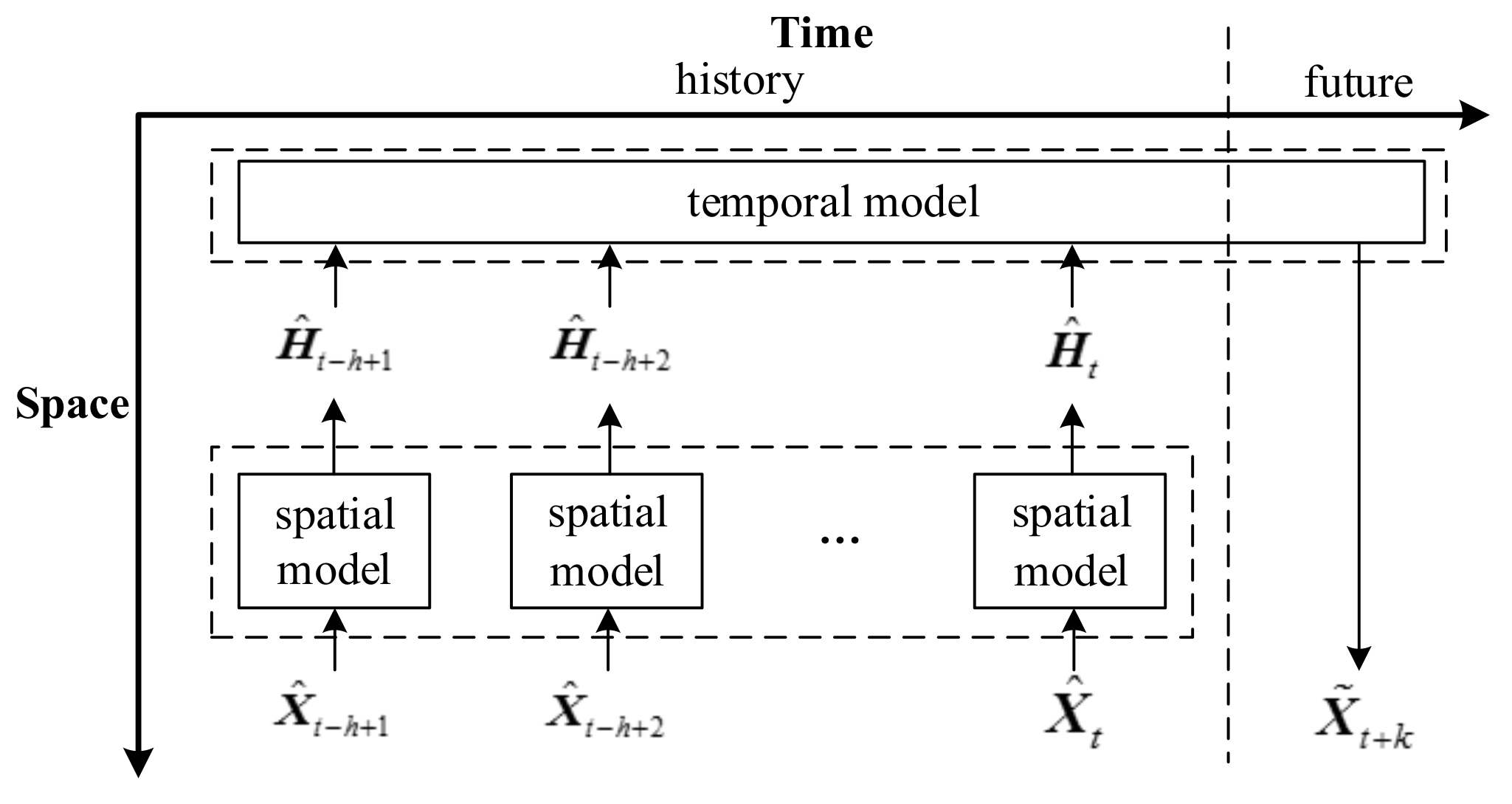
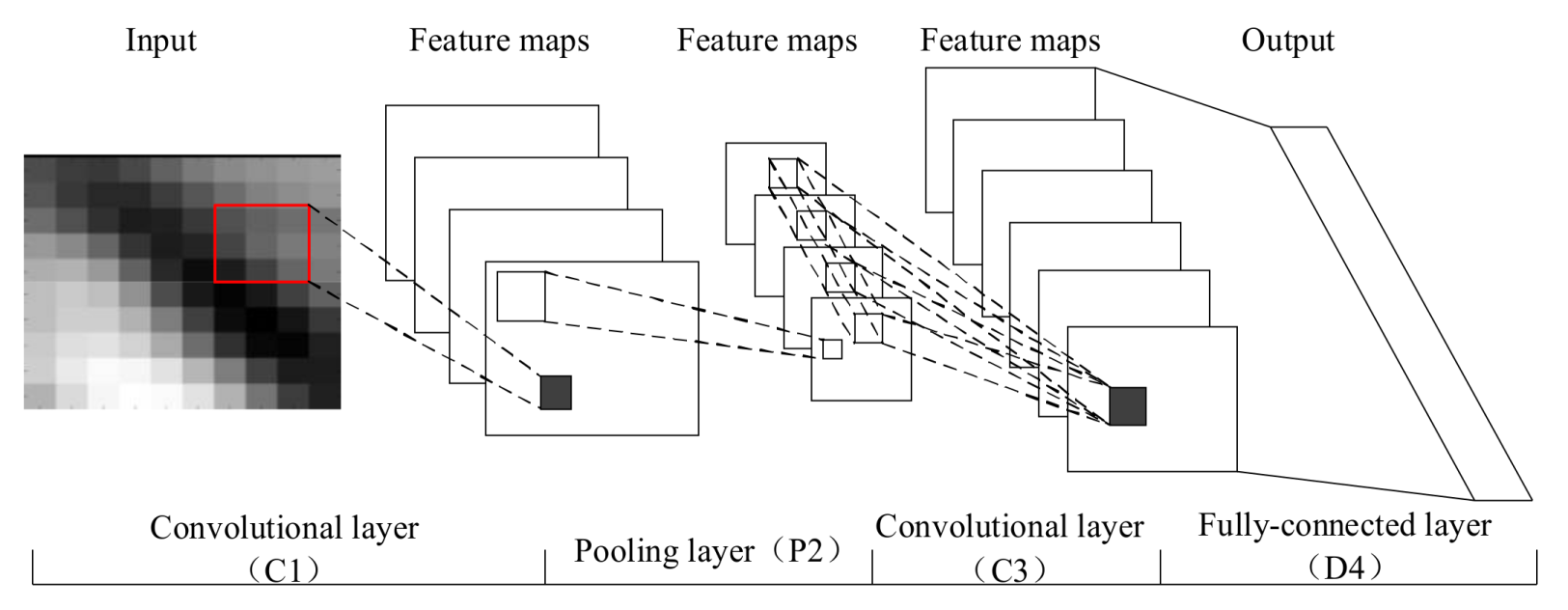
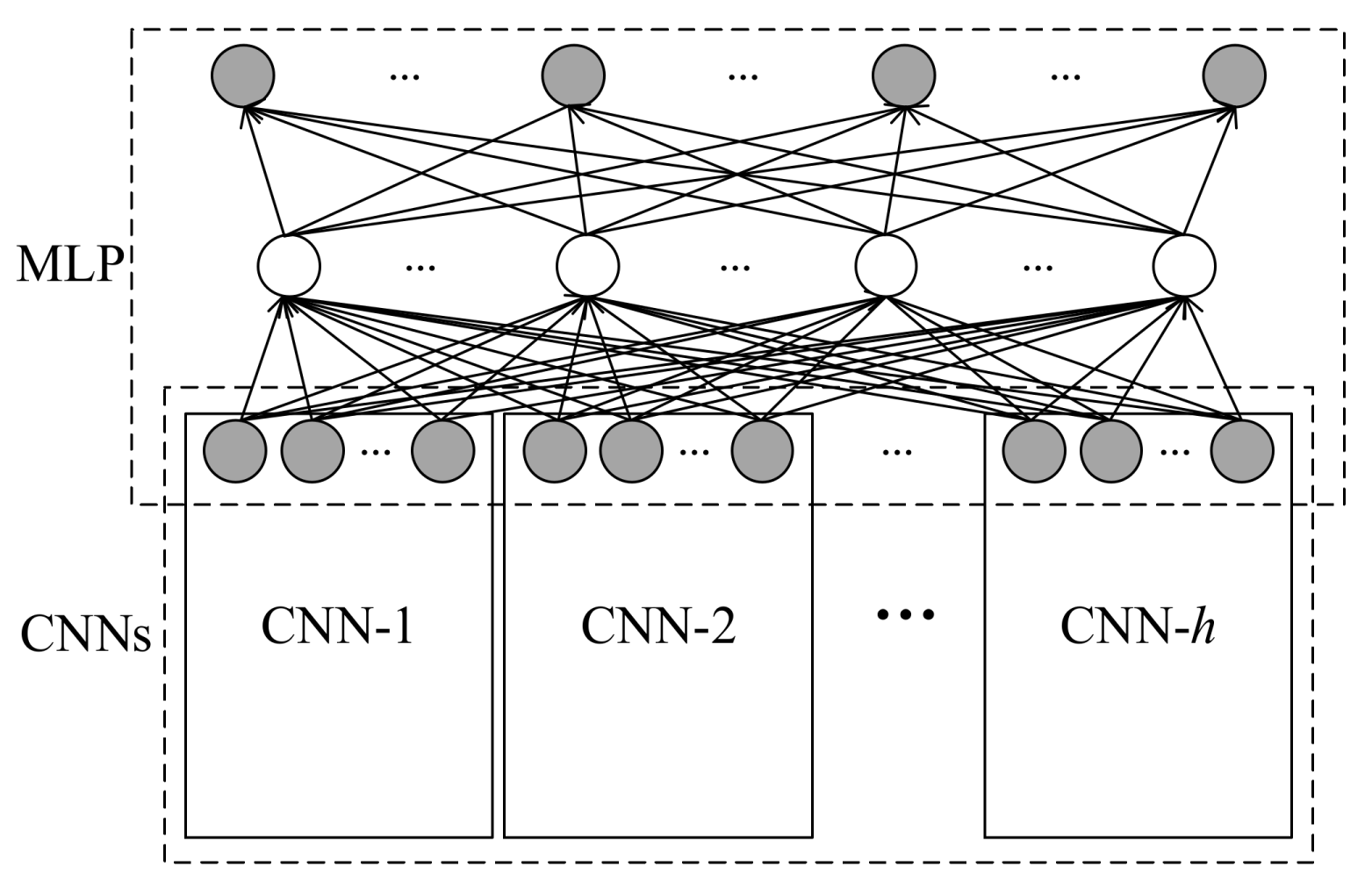
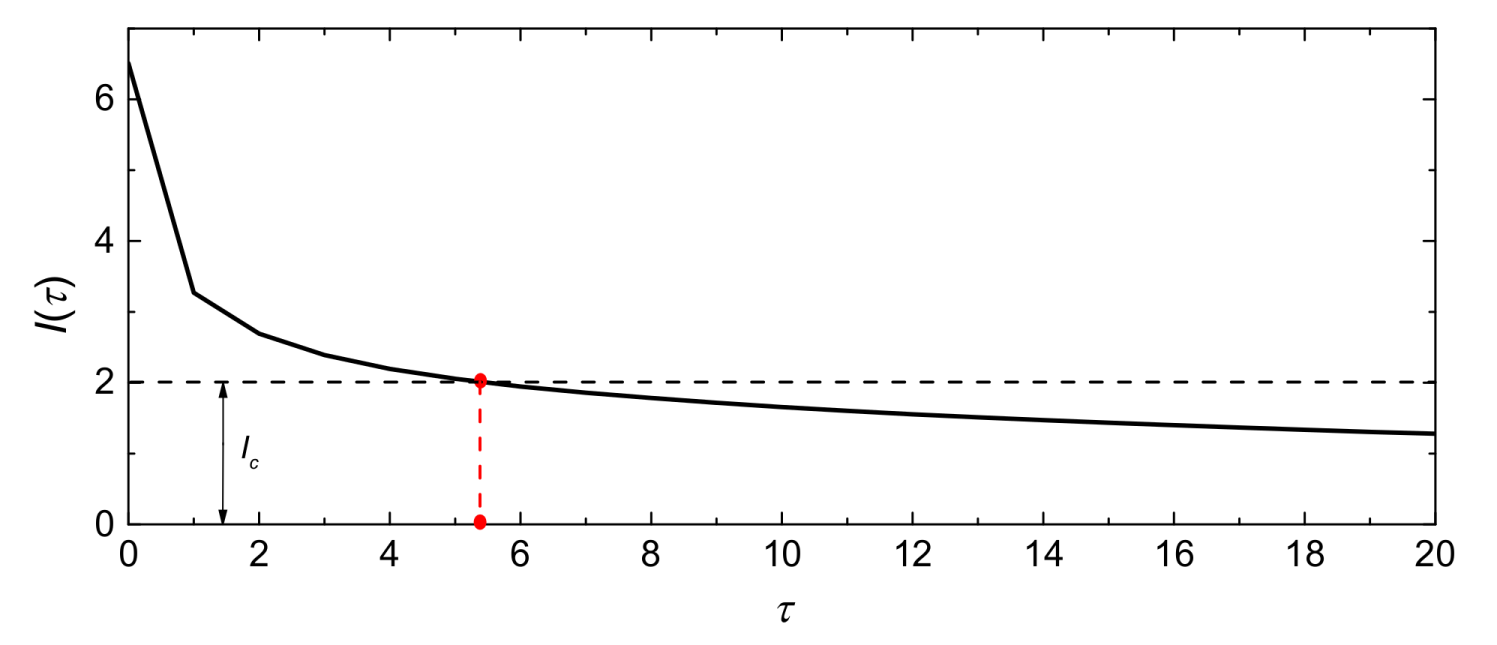
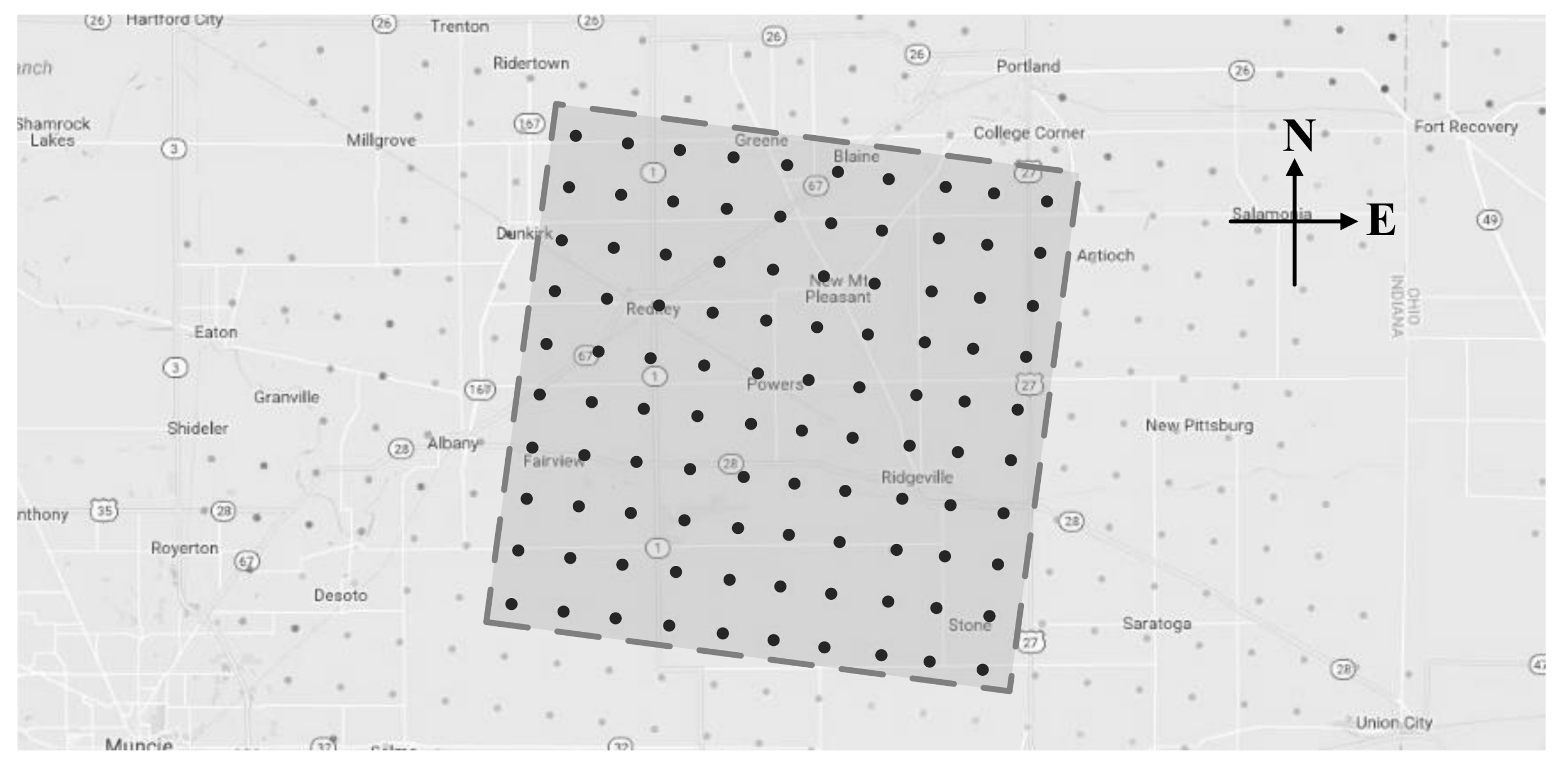
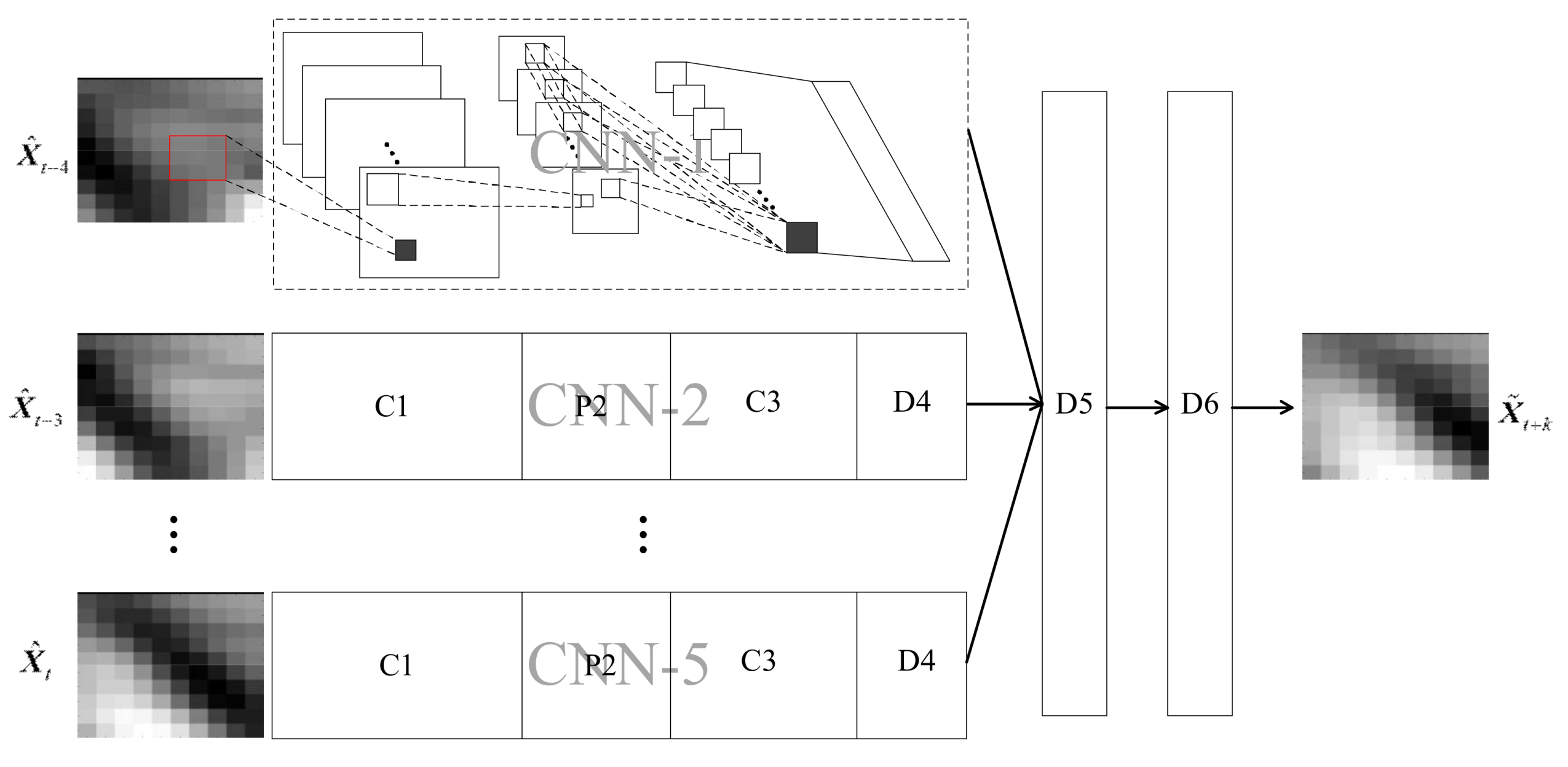
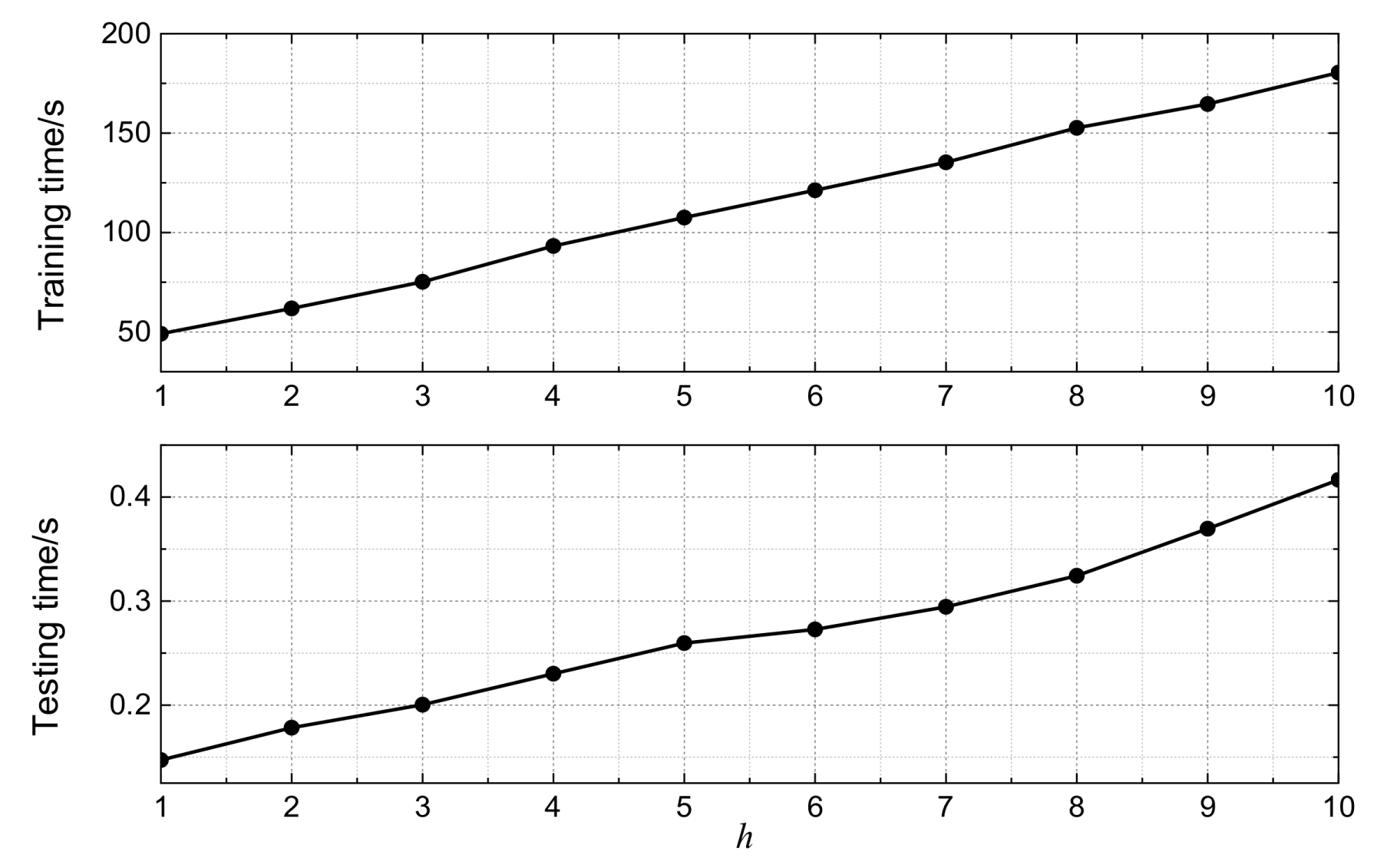
| Prediction Horizon (Min) | PDCNN | MLP | SVR | DT | |
|---|---|---|---|---|---|
| a | b | C | γ | e | |
| 5 | 200 | 500 | 0.1 | 0.5 | 6 |
| 10 | 200 | 500 | 1.0 | 0.5 | 6 |
| 15 | 200 | 600 | 1.0 | 0.5 | 6 |
| 20 | 300 | 400 | 1.0 | 0.5 | 6 |
| 25 | 200 | 600 | 0.1 | 0.5 | 5 |
| 30 | 200 | 500 | 0.1 | 0.5 | 6 |
| 35 | 200 | 500 | 0.1 | 0.5 | 5 |
| 40 | 200 | 400 | 0.1 | 0.5 | 5 |
| 45 | 200 | 600 | 0.1 | 0.5 | 5 |
| 50 | 200 | 600 | 1.0 | 0.5 | 5 |
| 55 | 300 | 600 | 0.1 | 0.5 | 4 |
| 60 | 200 | 500 | 0.1 | 0.5 | 5 |
| Prediction Horizon (Min) | PR | MLP | SVR | DT | PDCNN |
|---|---|---|---|---|---|
| 5 | 7.179 | 6.665 | 6.901 | 6.740 | 4.414 |
| 10 | 8.246 | 7.091 | 7.455 | 7.194 | 5.463 |
| 15 | 9.153 | 7.756 | 7.343 | 7.402 | 5.526 |
| 20 | 9.804 | 8.046 | 7.746 | 8.070 | 6.299 |
| 25 | 11.058 | 9.085 | 8.535 | 8.395 | 6.703 |
| 30 | 12.197 | 9.619 | 9.371 | 9.105 | 6.992 |
| 35 | 13.259 | 10.311 | 9.990 | 10.008 | 7.252 |
| 40 | 14.236 | 10.663 | 10.790 | 11.471 | 7.622 |
| 45 | 15.105 | 11.240 | 11.670 | 11.498 | 8.183 |
| 50 | 15.905 | 11.597 | 12.608 | 12.799 | 8.912 |
| 55 | 16.677 | 12.418 | 13.378 | 13.028 | 8.948 |
| 60 | 17.431 | 13.170 | 14.223 | 14.018 | 9.306 |
| Prediction Horizon (Min) | PR | MLP | SVR | DT | PDCNN |
|---|---|---|---|---|---|
| 5 | 0.621 | 0.582 | 0.600 | 0.592 | 0.400 |
| 10 | 0.674 | 0.624 | 0.644 | 0.635 | 0.501 |
| 15 | 0.833 | 0.687 | 0.708 | 0.689 | 0.543 |
| 20 | 0.960 | 0.717 | 0.739 | 0.735 | 0.634 |
| 25 | 1.066 | 0.801 | 0.826 | 0.816 | 0.656 |
| 30 | 1.161 | 0.847 | 0.873 | 0.843 | 0.720 |
| 35 | 1.247 | 0.902 | 0.930 | 0.921 | 0.750 |
| 40 | 1.326 | 0.947 | 0.976 | 0.965 | 0.790 |
| 45 | 1.399 | 0.986 | 1.016 | 1.015 | 0.875 |
| 50 | 1.465 | 1.018 | 1.049 | 1.038 | 0.940 |
| 55 | 1.528 | 1.085 | 1.118 | 1.160 | 0.947 |
| 60 | 1.588 | 1.165 | 1.201 | 1.193 | 0.977 |
| Prediction Horizon (Min) | PR | MLP | SVR | DT | PDCNN |
|---|---|---|---|---|---|
| 5 | 32.580 | 22.431 | 20.002 | 25.346 | 17.699 |
| 10 | 34.980 | 22.893 | 20.159 | 26.684 | 18.740 |
| 15 | 36.192 | 25.046 | 21.786 | 27.701 | 21.676 |
| 20 | 37.309 | 25.218 | 24.866 | 30.511 | 22.604 |
| 25 | 38.864 | 27.863 | 27.719 | 31.746 | 24.401 |
| 30 | 40.938 | 28.698 | 29.225 | 31.667 | 25.073 |
| 35 | 41.372 | 29.663 | 29.740 | 32.263 | 26.432 |
| 40 | 44.152 | 33.970 | 30.308 | 39.056 | 29.785 |
| 45 | 45.256 | 34.107 | 31.584 | 39.440 | 29.884 |
| 50 | 47.206 | 34.962 | 34.350 | 39.930 | 30.687 |
| 55 | 48.028 | 37.162 | 35.484 | 40.406 | 32.159 |
| 60 | 47.466 | 37.863 | 35.125 | 41.254 | 32.336 |
| Prediction Horizon (Min) | A-MAPE (%) | A-RMSE (m/s) | MIE (m/s) |
|---|---|---|---|
| 5 | 6.531 | 0.531 | 25.621 |
| 10 | 7.102 | 0.632 | 26.927 |
| 15 | 7.903 | 0.792 | 27.942 |
| 20 | 9.223 | 0.903 | 32.801 |
| 25 | 10.121 | 0.974 | 36.468 |
| 30 | 11.742 | 1.101 | 39.231 |
| 35 | 12.831 | 1.123 | 40.403 |
| 40 | 13.505 | 1.184 | 41.039 |
| 45 | 14.242 | 1.235 | 41.847 |
| 50 | 14.993 | 1.296 | 42.741 |
| 55 | 15.634 | 1.342 | 43.525 |
| 60 | 16.014 | 1.391 | 44.932 |
© 2018 by the authors. Licensee MDPI, Basel, Switzerland. This article is an open access article distributed under the terms and conditions of the Creative Commons Attribution (CC BY) license (http://creativecommons.org/licenses/by/4.0/).
Share and Cite
Zhu, Q.; Chen, J.; Zhu, L.; Duan, X.; Liu, Y. Wind Speed Prediction with Spatio–Temporal Correlation: A Deep Learning Approach. Energies 2018, 11, 705. https://doi.org/10.3390/en11040705
Zhu Q, Chen J, Zhu L, Duan X, Liu Y. Wind Speed Prediction with Spatio–Temporal Correlation: A Deep Learning Approach. Energies. 2018; 11(4):705. https://doi.org/10.3390/en11040705
Chicago/Turabian StyleZhu, Qiaomu, Jinfu Chen, Lin Zhu, Xianzhong Duan, and Yilu Liu. 2018. "Wind Speed Prediction with Spatio–Temporal Correlation: A Deep Learning Approach" Energies 11, no. 4: 705. https://doi.org/10.3390/en11040705





